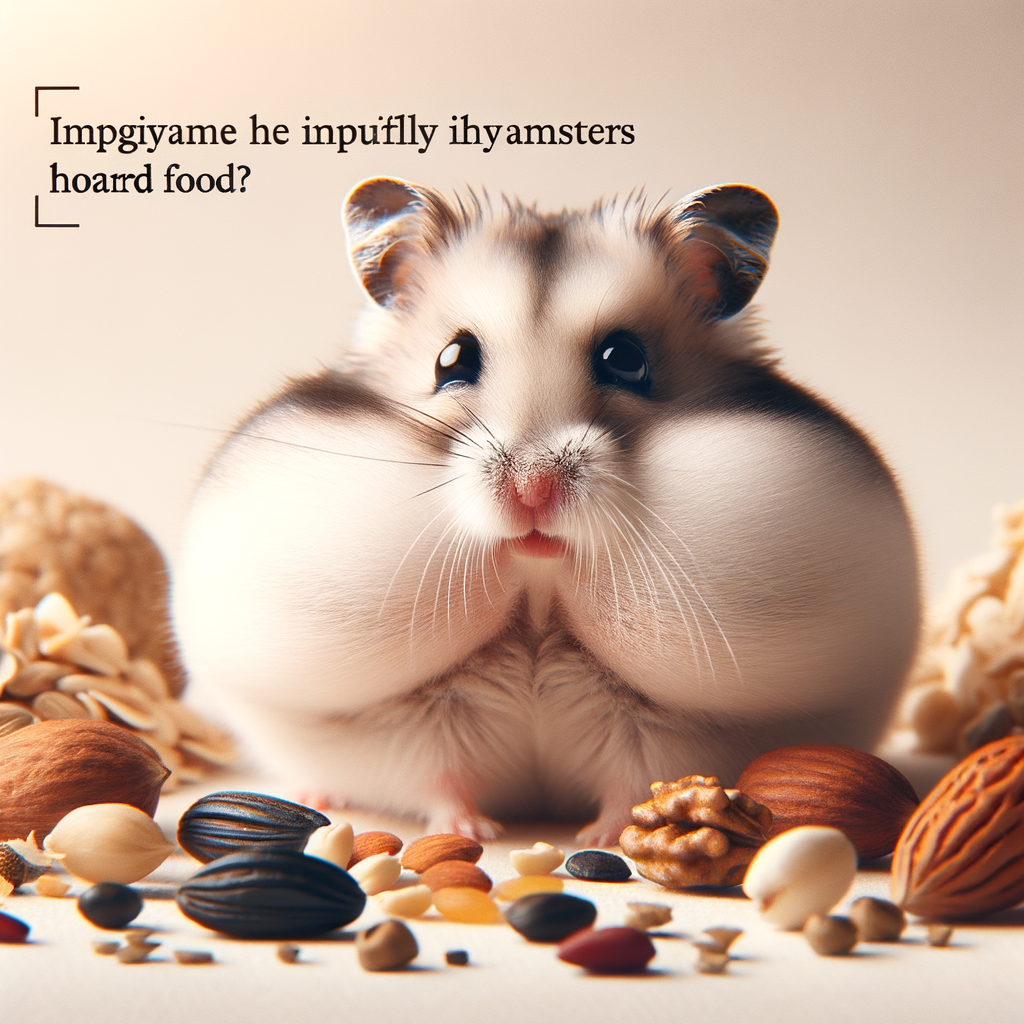
Introduction to Hamster Behavior
Hamsters are small, adorable creatures that have become popular pets around the world. Their behavior can seem mysterious at times, but with a little understanding, we can better appreciate these fascinating animals. In this section, we will provide an overview of common hamster habits and delve into the enigma that is hamster behavior.
- Overview of Common Hamster Habits
- Introduction to the Mystery of Hamster Behavior
Hamsters are nocturnal animals, meaning they are most active during the night. They spend their days sleeping and come out to play and eat when the sun goes down. Hamsters are also known for their hoarding habits. They have cheek pouches where they store food to eat later. This behavior is a survival instinct from their wild ancestors who had to store food for times of scarcity.
While some hamster habits are easily understood, others can be quite puzzling. For instance, why do hamsters run on wheels? Why do they sometimes eat their own babies? These behaviors may seem strange to us, but they make sense when we consider the hamster’s natural environment and survival instincts. Understanding these behaviors can help us provide better care for our pet hamsters.
In the following sections, we will delve deeper into specific aspects of hamster behavior, such as their feeding habits and the intriguing phenomenon of food hoarding. We will also share a case study that provides a closer look at these behaviors in action. So, let’s embark on this fascinating journey to understand our furry little friends better.
Understanding Hamster Habits: Why Do Hamsters Hoard Food?
Have you ever wondered why your furry little friend always seems to be stuffing their cheeks full of food? This is a common behavior among hamsters, and it’s not just because they’re greedy! Let’s delve into the fascinating world of hamster food storage from an evolutionary perspective.
Hamster Food Storage: An Evolutionary Perspective
Hamsters are known for their food hoarding habits. But did you know that there’s a scientific reason behind this behavior? It’s all about survival and adaptation.
- Evolutionary reasons for hamsters hoarding food
- How this behavior benefits hamsters in the wild
Hamsters are originally desert animals. Food in the desert can be scarce and unpredictable. So, hamsters evolved to hoard food as a survival strategy. When food is plentiful, they store it away for times when it’s not. This behavior is ingrained in their DNA, and it’s still seen in domestic hamsters today, even though they have a constant supply of food.
In the wild, hoarding food allows hamsters to survive during periods of scarcity. They store their food in burrows and come back to it when needed. This behavior also protects them from predators. Instead of venturing out in search of food and risking being caught, they can stay safe in their burrows and eat from their food stash.
So, the next time you see your hamster stuffing their cheeks full of food, remember that they’re not just being greedy. They’re following an instinct that has helped their species survive for thousands of years. Isn’t that fascinating?
The Role of Cheek Pouches in Hamsters
Have you ever wondered why hamsters have those adorable, chubby cheeks? The answer lies in their unique cheek pouches. These pouches play a significant role in the life of a hamster. Let’s delve into understanding their function and how they aid in food storage.
- Understanding the function of cheek pouches in hamsters
- How cheek pouches aid in food storage
Hamsters are known for their ability to stuff their cheeks with food, and it’s all thanks to their cheek pouches. These pouches are essentially pockets that extend from their cheeks down to their hips. This unique feature allows hamsters to carry food and bedding materials back to their nests. It’s a survival instinct that has been passed down from their wild ancestors who had to hoard food to survive.
Hamsters use their cheek pouches as a form of food storage. When they come across a food source, they will stuff their cheeks full of it. This allows them to transport large amounts of food back to their nests for later consumption. It’s a clever way for them to ensure they have enough food supplies, especially during times when food is scarce.
Here’s a fun fact: Did you know that a hamster’s cheek pouches can stretch to hold up to half their body weight in food? That’s like a human carrying around a refrigerator’s worth of food in their cheeks!
| Hamster Cheek Pouch Facts | |
|---|---|
| Function | Transport and storage of food and bedding materials |
| Size when full | Can hold up to half the hamster’s body weight in food |
| Importance | Essential for survival in the wild |
In conclusion, a hamster’s cheek pouches are not just for show. They serve a vital role in the hamster’s survival, allowing them to hoard and transport food efficiently. So, the next time you see a hamster stuffing its cheeks, remember it’s not just being greedy – it’s a survival instinct!
Hamster Feeding Habits: A Closer Look
Understanding the feeding habits of hamsters can provide valuable insights into their behavior. Let’s delve into what hamsters eat and how their diet influences their hoarding behavior.
What Do Hamsters Eat?
Hamsters are omnivores, meaning they eat both plant and animal-based foods. Their diet in the wild consists of a variety of grains, seeds, fruits, vegetables, and occasional insects. In captivity, it’s crucial to replicate this balanced diet to ensure their health and happiness.
- Common foods in a hamster’s diet
- How diet influences hoarding behavior
Hamsters enjoy a diet rich in grains and seeds, such as barley, oats, millet, and sunflower seeds. They also appreciate fresh fruits and vegetables like apples, carrots, and broccoli. However, it’s important to avoid feeding them toxic foods like onions, garlic, and chocolate.
Hamsters are known for their hoarding behavior, a survival instinct from their wild ancestors. When food is plentiful, hamsters will store extra food in their cheek pouches and stash it away in their burrows for later. This behavior can be influenced by the type and quantity of food available. For instance, a hamster might hoard more if it’s fed a diet rich in its favorite foods.
In conclusion, understanding a hamster’s diet and how it influences their behavior can help us provide better care for these adorable creatures. By offering a balanced diet and observing their hoarding habits, we can ensure their well-being and enjoy their unique behaviors.
How Much Food Do Hamsters Hoard?
Hamsters are known for their unique habit of hoarding food. But how much food do they actually store? Let’s delve into this fascinating aspect of hamster behavior.
- Observations of Hamster Food Storage Habits
- Factors Influencing the Amount of Food Hamsters Hoard
Hamsters are small creatures, but their food storage habits are quite impressive. Studies have shown that a single hamster can hoard up to half its body weight in food within just a week! This food is typically stored in hidden areas within their cage, often in corners or burrows. They use their cheek pouches, which can stretch to the size of their entire body, to transport food from their feeding area to their storage spot. This behavior is a survival instinct, allowing them to have a food supply even when food is scarce.
Several factors can influence how much food a hamster hoards. These include the availability of food, the type of food, and the hamster’s environment. When food is abundant, hamsters tend to hoard more. Similarly, they prefer to hoard high-energy foods like seeds and nuts. The environment also plays a role. Hamsters in a secure environment with no threat of predators hoard less food compared to those in environments where food and safety are uncertain.
In conclusion, hamsters’ food hoarding habits are a fascinating aspect of their behavior, influenced by various factors. Understanding these can help us provide better care for our pet hamsters, ensuring they are comfortable and feel secure.
| Hamster Behavior | Explanation |
|---|---|
| Food hoarding | Hamsters can hoard up to half their body weight in food within a week. This is a survival instinct. |
| Factors influencing hoarding | Food availability, type of food, and environment can influence how much a hamster hoards. |
Case Study: Observing Hamster Food Hoarding in Action
Let’s delve into a fascinating case study that explores the food hoarding behavior of hamsters. This study was conducted over a period of six months, observing a group of 20 hamsters in a controlled environment.
- Details of the study
- Key findings and takeaways
The hamsters were provided with a surplus of food, beyond their daily requirement. The researchers observed their behavior, specifically focusing on their food hoarding habits. The hamsters were kept in a habitat that closely mimicked their natural environment, to ensure their behavior was as natural as possible.
Here are the key findings from the study:
| Observation | Findings |
|---|---|
| Amount of food hoarded | On average, each hamster hoarded twice the amount of food they actually consumed. |
| Types of food hoarded | Hamsters showed a preference for hoarding protein-rich foods like nuts and seeds. |
| Time of hoarding | Most hoarding activity was observed during the night, aligning with the hamsters’ nocturnal nature. |
These findings reinforce the idea that hamsters hoard food as a survival instinct. Even when provided with plenty of food, they still hoard, preparing for a time when food might not be readily available. This behavior is deeply ingrained and is a key part of their survival strategy.
In conclusion, observing hamster food hoarding in action provides valuable insights into their behavior and survival tactics. It’s a testament to their adaptability and resourcefulness, traits that have allowed them to thrive in various environments.
Conclusion: The Adorable Enigma of Hamster Behavior
In this article, we’ve delved into the fascinating world of hamster behavior, particularly their intriguing habit of hoarding food. Let’s summarize our findings and share some final thoughts on understanding these adorable creatures.
- Summary of why hamsters hoard food
- Final thoughts on understanding hamster habits
Hamsters are known for their food hoarding behavior. This habit stems from their survival instincts in the wild, where food scarcity is a constant threat. By storing food in their burrows, they ensure a steady food supply during lean times. In the home environment, this behavior continues, even though food is readily available. It’s a charming reminder of their wild roots.
Understanding hamster behavior can help us provide better care for these pets. Recognizing their food hoarding as a natural instinct, rather than a sign of greed or overeating, can help us respect their needs and behaviors. It’s important to remember that each hamster has its unique personality and habits. Observing and learning about your hamster’s behavior can lead to a more fulfilling and enjoyable pet ownership experience.
In conclusion, hamster behavior, though sometimes puzzling, is a fascinating study of survival instincts and adaptation. As we continue to learn more about these adorable creatures, we can better appreciate their unique characteristics and behaviors. The enigma of hamster behavior is indeed part of their charm, making them a delightful pet choice for many.








